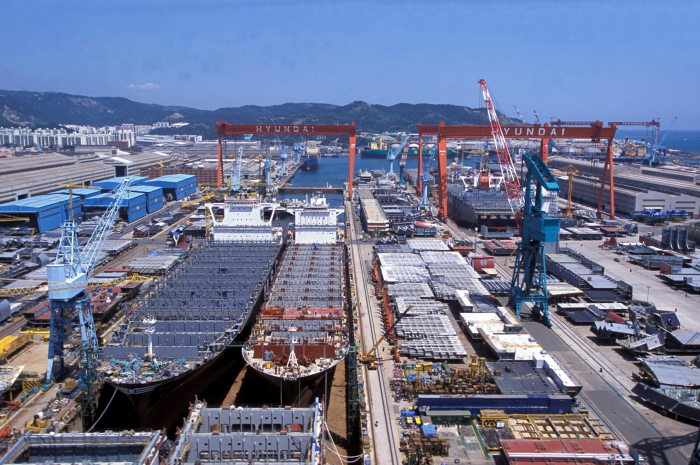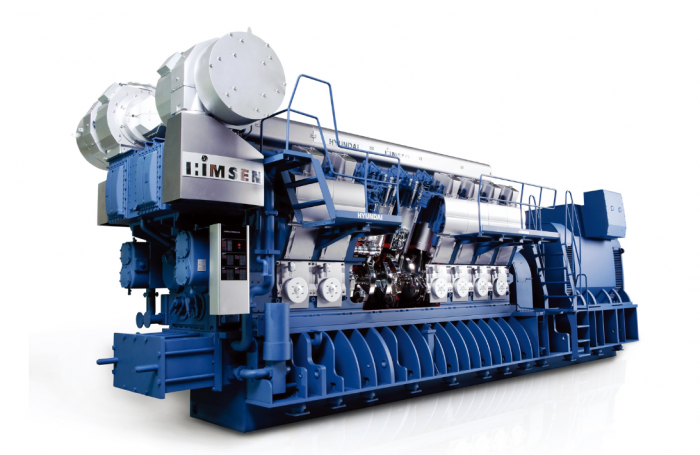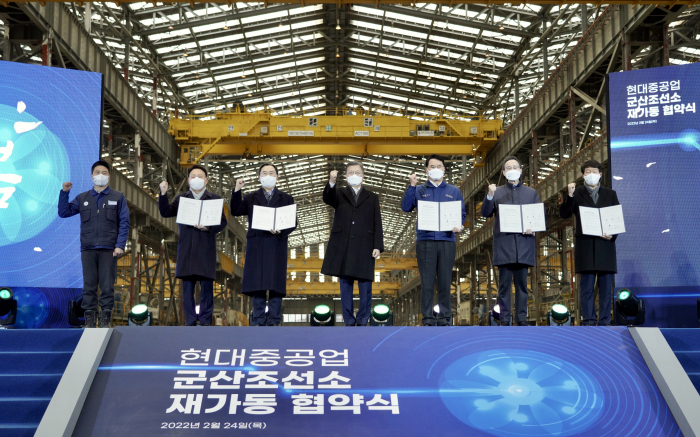Shipping & Shipbuilding
Hyundai's first Saudi JV shipyard slated for 2023 completion
Hyundai Heavy's engine production JV in Saudi Arabia is also scheduled to be completed next year
By Mar 02, 2022 (Gmt+09:00)
3
Min read
Most Read
LG Chem to sell water filter business to Glenwood PE for $692 million


Kyobo Life poised to buy Japan’s SBI Group-owned savings bank


KT&G eyes overseas M&A after rejecting activist fund's offer


StockX in merger talks with Naver’s online reseller Kream


Mirae Asset to be named Korea Post’s core real estate fund operator



South Korea's Hyundai Heavy Industries Holdings Co. is scheduled to construct a large-scale shipyard for very large crude carriers (VLCCs) and a marine engine plant in Saudi Arabia next year, jointly with its local partners in the Middle East.
The new overseas facilities will become the world's largest shipbuilder's first jointly-owned plants in the region and mark its new step forward to become a technology platform for ships.
In the face of growing protectionism and intensifying competition from Chinese shipyards, Hyundai Heavy has changed tack to build joint ventures (JVs) abroad and use them both as shipbuilders in the low-end market and as clients.
In 2017, Hyundai Heavy set up International Maritime Industries (IMI) in Saudi Arabia, a JV with Saudi's state-run oil producer Aramco; Bahri, Saudi's state-owned shipping company; and Lamprell, a United Arab Emirates-based construction company for energy infrastructure.
The venture's shipyard, to be located on Saudi Arabia’s east coast, is a project estimated at over 5 trillion won ($4.2 billion).
To the shipyard, Hyundai's sub-holding company Korea Shipbuilding & Offshore Engineering Co. (KSOE) transfers architectural designs and the related technology to build VLCCs, while providing training to its employees as a shareholder with a 20% stake.
In return, KSOE will receive a royalty on every VLCC to be built by IMI, which has already secured orders from two of its shareholders -- Saudi Aramco and Bahri -- to construct more than 50 VLCCs.
"It's a technology export strategy, different from our previous overseas expansion aimed at cutting manufacturing costs," a KSOE official said on Mar. 1.
ENGINE PLANT
KSOE is also building an engine plant in the Middle East via Saudi Engines Manufacturing Co. (Semco), a joint venture with Aramco and an investment company Dussur. The Hyundai Heavy's unit controls 30% of the JV.
The engine plant will manufacture the HiMSEN engine, a medium-sized engine independently developed by KSOE.
It is set to become the first marine engine manufacturing facility in the Middle East and North Africa, as well as the first overseas plant to produce Hyundai's patented HiMSEN engine.
"It will mark the first time for our HiMSEN engines to be produced abroad and for a Korean company to export engine parts," the KSOE official said.
In return for technology transfer and know-how, KSOE will win royalties from the plant, which will also procure a bulk of engine components from South Korea.
KSOE controls three shipbuilders: Hyundai Heavy Industries Co., Hyundai Mipo Dockyard Co. and Hyundai Samho Heavy Industries Co.

In Russia, Hyundai Samho Heavy Industries in 2017 established a 49:51 JV with Russia's largest shipbuilder Zvezda to build a shipyard.
Their shipbuilding complex in Russia became the first shipyard abroad, under a licensing agreement between a South Korean shipbuilder and a foreign company.
Hyundai transferred its shipbuilding technology to the JV named Zvezda-Hyundai, which paid royalties to Hyundai. The Korean shipbuilder also received an Aframax vessel order from the JV and delivered it last year. Aframax stands for the Average Freight Rate Assessment (AFRA), a freight billing system.
In Vietnam, Hyundai has been operating a JV with Vietnam's state-run shipyard in 1996. The venture primarily manufacturers medium-sized crude oil tankers and bulk carriers, competing with Chinese rivals.
"The ships constructed in Saudi Arabia, Russia and Vietnam are the target models of Chinese shipbuilders," the KSOE official noted.
"We will support our overseas shipyards in emerging markets to help them keep Chinese shipbuilders from increasing their dominance. At home, we will put our focus into high-value-added vessels such as LNG carriers."

Hyundai Heavy Industries Holdings last week announced a plan to change its name to HD Hyundai, to shed its image as a traditional manufacturer.
The shipbuilder is seeking to grow its presence in the tech-oriented segment of the shipbuilding sector such as artificial intelligence (AI) software systems to provide information on optimal ship routes and replacement periods for ship components.
Write to Jung-hwan Hwang at jung@hankyung.com
Yeonhee Kim edited this article
More to Read
-
 Shipping & ShipbuildingHyundai, Daewoo race for ship orders after merger fails
Shipping & ShipbuildingHyundai, Daewoo race for ship orders after merger failsFeb 04, 2022 (Gmt+09:00)
2 Min read -
 Mergers & AcquisitionsHyundai Heavy, DSME merger falls through on EU veto
Mergers & AcquisitionsHyundai Heavy, DSME merger falls through on EU vetoJan 14, 2022 (Gmt+09:00)
5 Min read -
 Shipping & ShipbuildingHyundai Heavy uneasy ahead of EU decision despite $2.5 bn orders
Shipping & ShipbuildingHyundai Heavy uneasy ahead of EU decision despite $2.5 bn ordersJan 11, 2022 (Gmt+09:00)
3 Min read
Comment 0
LOG IN


